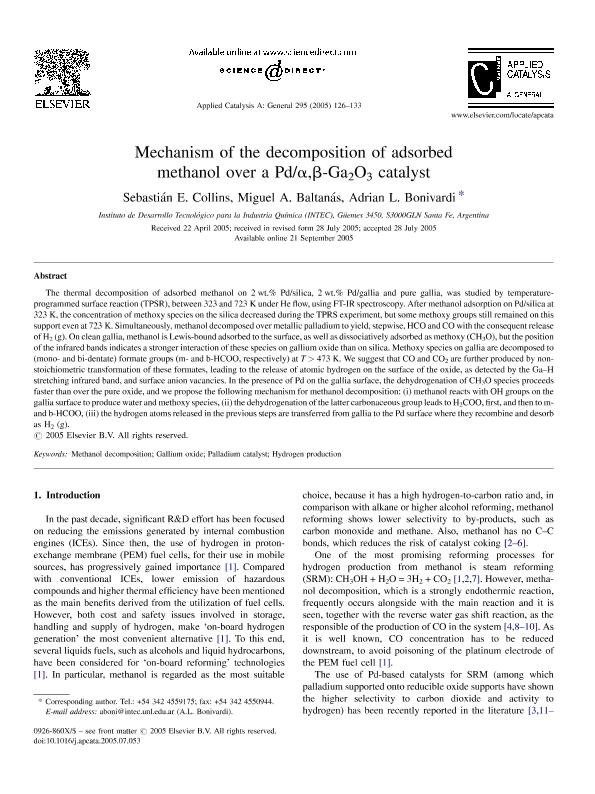Artículo
Mechanism of the decomposition of adsorbed methanol over a Pd/α,β-Ga2O3 catalyst
Fecha de publicación:
12/2005
Editorial:
Elsevier Science
Revista:
Applied Catalysis A: General
ISSN:
0926-860X
Idioma:
Inglés
Tipo de recurso:
Artículo publicado
Clasificación temática:
Resumen
The thermal decomposition of adsorbed methanol on 2 wt.% Pd/silica, 2 wt.% Pd/gallia and pure gallia, was studied by temperatureprogrammed surface reaction (TPSR), between 323 and 723 K under He flow, using FT-IR spectroscopy. After methanol adsorption on Pd/silica at 323 K, the concentration of methoxy species on the silica decreased during the TPRS experiment, but some methoxy groups still remained on this support even at 723 K. Simultaneously, methanol decomposed over metallic palladium to yield, stepwise, HCO and CO with the consequent release of H2 (g). On clean gallia, methanol is Lewis-bound adsorbed to the surface, as well as dissociatively adsorbed as methoxy (CH3O), but the position of the infrared bands indicates a stronger interaction of these species on gallium oxide than on silica. Methoxy species on gallia are decomposed to (mono- and bi-dentate) formate groups (m- and b-HCOO, respectively) at T > 473 K. We suggest that CO and CO2 are further produced by nonstoichiometric transformation of these formates, leading to the release of atomic hydrogen on the surface of the oxide, as detected by the Ga–H stretching infrared band, and surface anion vacancies. In the presence of Pd on the gallia surface, the dehydrogenation of CH3O species proceeds faster than over the pure oxide, and we propose the following mechanism for methanol decomposition: (i) methanol reacts with OH groups on the gallia surface to produce water and methoxy species, (ii) the dehydrogenation of the latter carbonaceous group leads to H2COO, first, and then to mand b-HCOO, (iii) the hydrogen atoms released in the previous steps are transferred from gallia to the Pd surface where they recombine and desorb as H2 (g).
Palabras clave:
Methanol
,
Decomposition
,
Palladium
,
Gallia
Archivos asociados
Licencia
Identificadores
Colecciones
Articulos(INTEC)
Articulos de INST.DE DES.TECNOL.PARA LA IND.QUIMICA (I)
Articulos de INST.DE DES.TECNOL.PARA LA IND.QUIMICA (I)
Citación
Collins, Sebastián Enrique; Baltanas, Miguel Angel; Bonivardi, Adrian Lionel; Mechanism of the decomposition of adsorbed methanol over a Pd/α,β-Ga2O3 catalyst; Elsevier Science; Applied Catalysis A: General; 296; 2; 12-2005; 126-133
Compartir
Altmétricas




